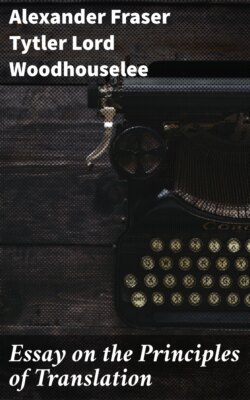Читать книгу Essay on the Principles of Translation - Alexander Fraser Tytler Lord Woodhouselee - Страница 6
На сайте Литреса книга снята с продажи.
CHAPTER I
ОглавлениеTable of Contents
DESCRIPTION OF A GOOD TRANSLATION—GENERAL RULES FLOWING FROM THAT DESCRIPTION
If it were possible accurately to define, or, perhaps more properly, to describe what is meant by a good Translation, it is evident that a considerable progress would be made towards establishing the Rules of the Art; for these Rules would flow naturally from that definition or description. But there is no subject of criticism where there has been so much difference of opinion. If the genius and character of all languages were the same, it would be an easy task to translate from one into another; nor would anything more be requisite on the part of the translator, than fidelity and attention. But as the genius and character of languages is confessedly very different, it has hence become a common opinion, that it is the duty of a translator to attend only to the sense and spirit of his original, to make himself perfectly master of his author’s ideas, and to communicate them in those expressions which he judges to be best suited to convey them. It has, on the other hand, been maintained, that, in order to constitute a perfect translation, it is not only requisite that the ideas and sentiments of the original author should be conveyed, but likewise his style and manner of writing, which, it is supposed, cannot be done without a strict attention to the arrangement of his sentences, and even to their order and construction.[6] According to the former idea of translation, it is allowable to improve and to embellish; according to the latter, it is necessary to preserve even blemishes and defects; and to these must, likewise be superadded the harshness that must attend every copy in which the artist scrupulously studies to imitate the minutest lines or traces of his original.
As these two opinions form opposite extremes, it is not improbable that the point of perfection should be found between the two. I would therefore describe a good translation to be, That, in which the merit of the original work is so completely transfused into another language, as to be as distinctly apprehended, and as strongly felt, by a native of the country to which that language belongs, as it is by those who speak the language of the original work.
Now, supposing this description to be a just one, which I think it is, let us examine what are the laws of translation which may be deduced from it.
It will follow,
I. That the Translation should give a complete transcript of the ideas of the original work.
II. That the style and manner of writing should be of the same character with that of the original.
III. That the Translation should have all the ease of original composition.
Under each of these general laws of translation, are comprehended a variety of subordinate precepts, which I shall notice in their order, and which, as well as the general laws, I shall endeavour to prove, and to illustrate by examples.
